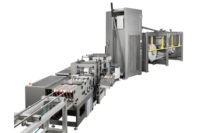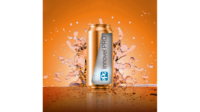Flexible Packaging caught up with Mark Miller, co-founder of Coating Tech Slot Dies, to discuss the state of slot die coating technology, resolution of coating defects and equipment-based design on fluid rheology for specific applications. Coating Tech Slot Dies is a precision manufacturing company and technical consulting company providing online services and technical training to operators and engineers in a wide range of industries.
Slot die coating technology is being used for a variety of manufacturing applications, including micro-electronics, lithium-ion battery electrodes, thin-film solar and multi-layer flexible packaging film substrates. Proper adhesive application to film layers is essential for reducing material costs by reducing scrap rates. Packaging film is used for items such as pet food, processed fruit and vegetables, and baby food packaging.
As more consumer good companies demand bespoke flexible packaging designs and recyclability, slot die applications are getting a closer look. According to Miller, converters are evaluating slot die technology due to the need for increased cleanliness, control and precision.
“Slot die technology creates the ability to design your fluid adhesives for how you want it to perform in packaging use and then have the equipment match the fluid design,” says Miller. “We’re seeing more research and development on fluids and adhesives for slot die applications compared to 10 years ago when roll coating was the technology of choice.”
More R&D on adhesives is crucial to reducing scrap, and it showcases the formidable challenge in combining dissimilar substrates within today’s packaging film, which also includes more recyclable materials. “If a slot die technology or roll coating system is involved that ties substrate layers between different materials, then the concerns are stresses within the adhesive layers that are critical in lamination,” says Miller.
The compelling difference between slot die technology and roll coating is the focus on the coating or adhesive materials in conjunction with the equipment design. For example, a research lab can create a high-viscosity adhesive for a specific packaging application which cannot be roll coated. Due to the slot-die equipment shearing and placing forces on the adhesive prior to coating on the substrate, the high viscosity adhesive can be utilized.
“Higher viscosity adhesives via slot die technology can produce more stress,” says Miller. “Once an adhesive is placed on the substrate, the coating may trigger ‘stress relaxation’ and the coating may want to retract.”
Miller notes retraction may cause curling or wrinkling with packaging film, and adhesive problems can occur due to adhesive curing before lamination. So adhesives can have stresses not only inside, but on the exterior of the adhesive. This points to the need for proper slot die design being critical to utilizing these higher viscosity adhesives.
The big takeaway for packaging film applications is understanding the adhesive rheology. “As companies look for packaging design that’s more precise, unique and has more value, they need to understand adhesives better,” says Miller. “In order to have less stress on the adhesives, slot die equipment coating needs to be precise and work with the adhesive, not against it.”
As a packaging film substrate on a web roll moves faster, the process can also create more stress and can cause breaks or wrinkling with lamination. If the equipment is properly designed, set up and operated, these defects can be overcome. Understanding the fluid rheology, the web handling and the equipment design are required for optimum product performance.
During a recent webinar on the topic, titled, “Slot Die Coating Defects and Resolution,” Miller cited chatter, ribbing, air entrainment, air entrapment, dewetting, streaks, particles, chevrons and hash marks as possible coating defects. While these coating defects can occur with any coating technique, Miller provided simple solutions during the webinar for these issues when slot die coating.
Slot Die Consulting
In addition to designing and manufacturing precision coating equipment, Coating Tech Slot Dies also offers consulting services for a range of customers, including converters. “Customers are looking for process development partners, along with excellent equipment technology,” says Miller. We provide technical answers for any coating issue that you might have.”
The company provides educational opportunities for operators and engineers in online and live classes, along with seminars. This is important as this new technology demands sharp operators and engineers. “If an operator has only done roll coating before, focused training on slot die coating technology helps make the transition smoother.” says Miller.
For example, slot die applications depend on pump management, among other things, to determine final coating thickness. Moreover, line speed of the substrate will also determine coating thickness.
In the recent webinar, Miller answered a question about coating speed and pump rate to increase outlet pressure without affecting the thickness and eliminate ribbing? Miller’s answer follows:
The issue is not proper pressure but that the liquid is not bridging the gap between the die and the substrate correctly. The gap between the slot die and the substrate needs to be the wet coating thickness to allow the fluid to form a proper dynamic wetting line. For example, let’s say a coat of 1 mil wet of a liquid, which would be 25 microns, and your gap between the die and substrate is currently 75 microns. The liquid doesn’t know to coat onto the substrate and a ribbing defect would occur until the distance between the slot die and substrate is reduced. Moving the slot die closer to the substrate to create a good bead development creates a stable meniscus and creates good fluid flow characteristic outside the slot die coating head. If you have to coat 1 mil (25 microns), you can increase line speed and increase pump rate to change pressure, but the liquid is still going to be confused once it exits the die until the distance matches the coating thickness.
That answer reveals the complexity of this new technology, but the consulting doesn’t stop there. Miller’s company also offers simulation to help in understanding a new liquid or adhesive, and how current slot die equipment can work with a new fluid.
“We have the ability to do finite element analysis, modeling of the fluid within the slot die,” says Miller. “We can tell a customer in approximately two weeks whether a fluid will work and here’s how your equipment needs to be set up.”
The compelling difference between slot die technology and roll coating is the focus on the coating or adhesive materials in conjunction with the equipment design.




